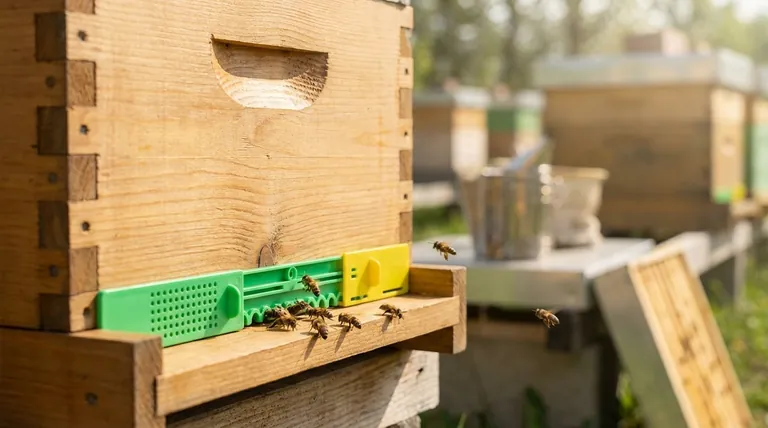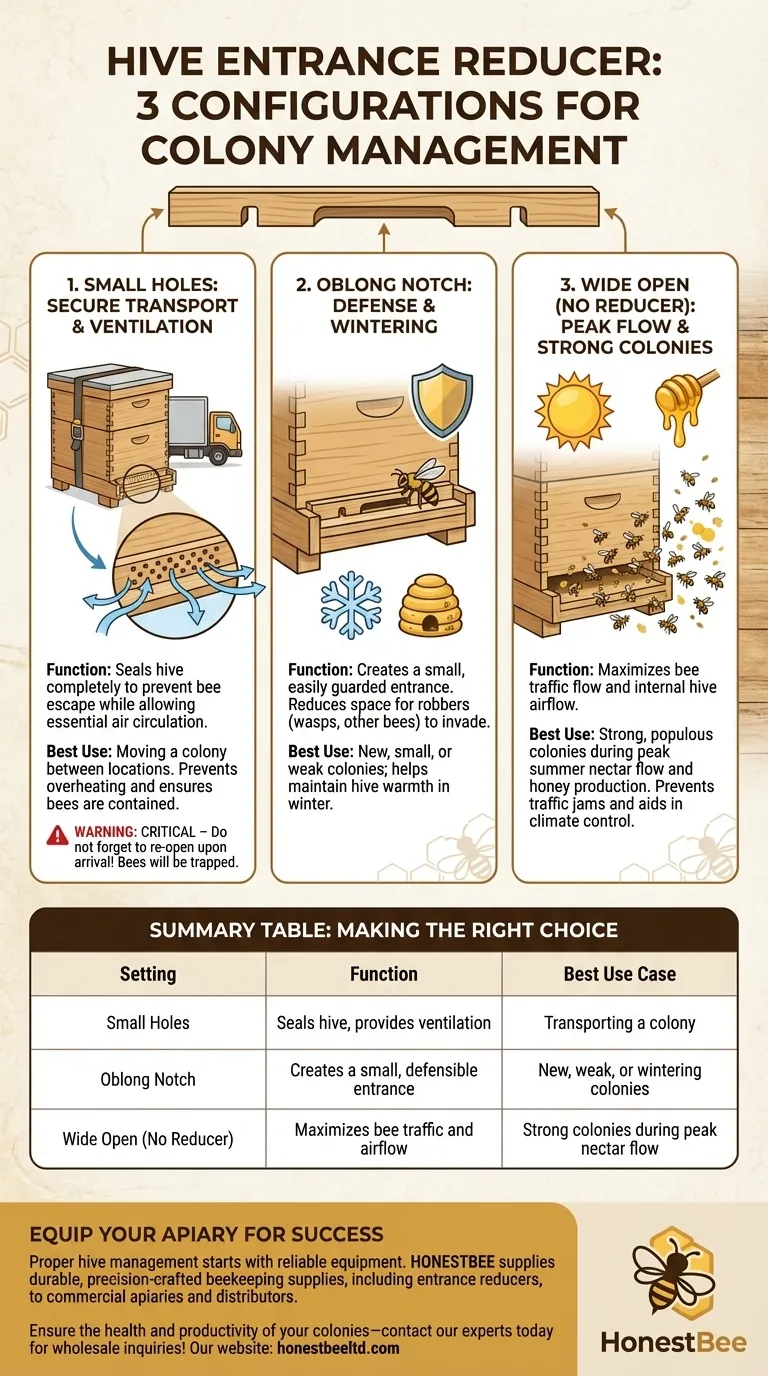In short, the side with the small holes is used for ventilation when you must completely seal the hive. This configuration prevents any bees from getting in or out, making it the correct setting for safely transporting a colony from one location to another without the risk of them overheating.
The beehive entrance reducer is not just one tool, but three. Understanding its different configurations allows you to control hive access and airflow, adapting to the colony's changing needs for defense, transport, or seasonal management.

The Purpose of Each Reducer Setting
A standard entrance reducer is a simple wooden bar with two different-sized notches. By rotating it, you provide three distinct entrance options for your hive: a small opening, a large opening (by flipping it over), or completely sealed with ventilation holes.
Position 1: Small Holes for Secure Transport
This is the setting that fully blocks bee access. The small, drilled holes are too tiny for bees to pass through but are essential for allowing air to circulate.
Its primary function is for moving a beehive. When you transport a colony, you must seal them inside to prevent them from escaping, but they still need to breathe. This setting ensures they remain securely contained while preventing dangerous overheating inside the hive.
Position 2: Oblong Notch for Defense
This setting provides a small, easily guarded entrance for the bees. It allows them to come and go for foraging but dramatically shrinks the space they need to defend from invaders.
This is the ideal setting for a new, small, or weak colony. A smaller population has a harder time repelling robbers from other hives or pests like wasps, and this reduced entrance gives them a significant defensive advantage. It's also commonly used during the winter to help the colony maintain warmth.
Position 3: Wide Open (No Reducer)
Removing the reducer entirely leaves the hive entrance fully open. This configuration is for strong, populous colonies, especially during the peak summer nectar flow.
A large, established colony needs maximum airflow to help manage internal temperature and cure honey. A wide-open entrance prevents traffic jams as thousands of forager bees are constantly flying in and out.
Common Pitfalls to Avoid
While simple, using the entrance reducer incorrectly can create significant problems for your bees. Understanding the potential mistakes is crucial for responsible hive management.
Forgetting to Re-open the Hive
The most critical mistake is forgetting to remove or rotate the reducer after moving a hive. If you leave the small-holed side in place, the bees are trapped. They cannot exit to forage for food or water, which will quickly harm the colony.
Using the Wrong Size Opening
Leaving a weak colony's entrance wide open invites robbing and can lead to the colony's collapse. Conversely, restricting a powerful colony with the small oblong notch during a summer heatwave can cause a "traffic jam," reducing foraging efficiency and contributing to overheating.
Making the Right Choice for Your Goal
Your colony's needs will change throughout the year. Use the entrance reducer as a tool to adapt to their situation.
- If your primary focus is moving the hive: Use the side with the small holes to lock the bees in safely while providing critical ventilation.
- If your primary focus is protecting a new or weak colony: Use the side with the larger oblong notch to create a small, defensible entrance.
- If your primary focus is maximizing foraging for a strong colony: Remove the reducer completely to allow for maximum bee traffic and airflow.
Properly using this simple piece of wood is a key step in managing a healthy and productive honeybee colony.
Summary Table:
| Setting | Function | Best Use Case |
|---|---|---|
| Small Holes | Seals hive, provides ventilation | Transporting a colony |
| Oblong Notch | Creates a small, defensible entrance | New, weak, or wintering colonies |
| Wide Open (No Reducer) | Maximizes bee traffic and airflow | Strong colonies during peak nectar flow |
Equip your apiary with the right tools for success. Proper hive management starts with reliable equipment. HONESTBEE supplies durable, precision-crafted beekeeping supplies and equipment, including entrance reducers, to commercial apiaries and beekeeping equipment distributors through our wholesale-focused operations. Ensure the health and productivity of your colonies—contact our experts today to discuss your wholesale needs!
Visual Guide

Related Products
- Multi-Functional Sliding Hive Entrance for Beekeeping
- Multi-Functional Rotary Hive Entrance Disc for Beekeeping
- Multi-Function Hive Tool with Integrated Hammer for Beekeeping
- Beehive Entrance Discs Plastic Bee Entrance Disc for Bee Hives
- Long Langstroth Style Horizontal Top Bar Hive for Wholesale
People Also Ask
- How does entrance configuration vary seasonally for beekeepers? A Guide to Year-Round Hive Health
- Why is a smaller entrance size beneficial for a beehive? Boost Hive Defense & Productivity
- How can a Langstroth hive entrance be adjusted? Mimic Natural Bee Preferences for a Healthier Hive
- How does the sliding design of the entrance reducer benefit beekeepers? Achieve Ultimate Hive Control
- What are the different entrance sizes for an 8 or 10-frame Langstroth hive? A Guide to Seasonal Management



















